
The Victory ship was a class of cargo ship produced in large numbers by American shipyards during World War II to replace losses caused by German submarines. They were a more modern design compared to the earlier Liberty ship, were slightly larger and had more powerful steam turbine engines, giving higher speed to allow participation in high-speed convoys and make them more difficult targets for German U-boats. A total of 531 Victory ships were built in between 1944 and 1946.
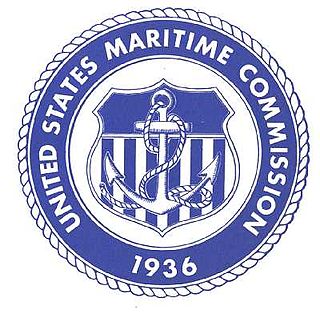
The United States Maritime Commission (MARCOM) was an independent executive agency of the U.S. federal government that was created by the Merchant Marine Act of 1936, which was passed by Congress on June 29, 1936, and was abolished on May 24, 1950. The commission replaced the United States Shipping Board which had existed since World War I. It was intended to formulate a merchant shipbuilding program to design and build five hundred modern merchant cargo ships to replace the World War I vintage vessels that comprised the bulk of the United States Merchant Marine, and to administer a subsidy system authorized by the Act to offset the cost differential between building in the U.S. and operating ships under the American flag. It also formed the United States Maritime Service for the training of seagoing ship's officers to man the new fleet.
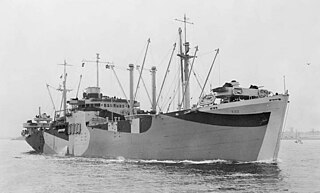
Type C1 was a designation for cargo ships built for the United States Maritime Commission before and during World War II. Total production was 493 ships built from 1940 to 1945. The first C1 types were the smallest of the three original Maritime Commission designs, meant for shorter routes where high speed and capacity were less important. Only a handful were delivered prior to Pearl Harbor. But many C1-A and C1-B ships were already in the works and were delivered during 1942. Many were converted to military purposes including troop transports during the war.
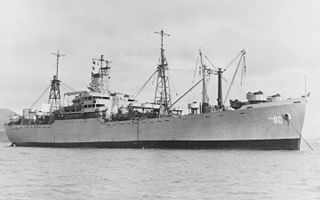
Type C2 ships were designed by the United States Maritime Commission (MARCOM) in 1937–38. They were all-purpose cargo ships with five holds, and U.S. shipyards built 328 of them from 1939 to 1945. Compared to ships built before 1939, the C2s were remarkable for their speed and fuel economy. Their design speed was 15.5 knots (28.7 km/h), but some could make 19 knots (35 km/h) on occasion. The first C2s were 459 feet (140 m) long, 63 feet (19 m) broad, and 40 feet (12 m) deep, with a 25-foot (8 m) draft. Later ships varied somewhat in size. Some, intended for specific trade routes, were built with significant modifications in length and capacity.

Attack transport is a United States Navy ship classification for a variant of ocean-going troopship adapted to transporting invasion forces ashore. Unlike standard troopships – often drafted from the merchant fleet – that rely on either a quay or tenders, attack transports carry their own fleet of landing craft, such as the landing craft, vehicle, personnel (LCVP) or Higgins boat.
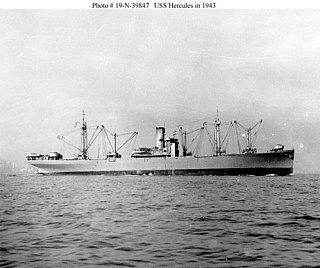
Type C3-class ships were the third type of cargo ship designed by the United States Maritime Commission (MARCOM) in the late 1930s. As it had done with the Type C1 ships and Type C2 ships, MARCOM circulated preliminary plans for comment. The design presented was not specific to any service or trade route, but was a general purpose ship that could be modified for specific uses. A total of 162 C3 ships were built from 1939 to 1946.

The General G. O. Squier class of transport ships was built for the U.S. Navy during World War II. The class was based upon the Maritime Commission's Type C4 ship. The class was named for United States Army Major General George Owen Squier.

The Type C4-class ship were the largest cargo ships built by the United States Maritime Commission (MARCOM) during World War II. The design was originally developed for the American-Hawaiian Lines in 1941, but in late 1941 the plans were taken over by the MARCOM.

SS Dalton Victory was built as Victory ship used as a cargo ship for World War II under the Emergency Shipbuilding program. She was launched by the California Shipbuilding Company on 6 June 1944 and completed on 19 July 1944 as a Greenville Victory-class cargo ship. The ship’s United States Maritime Commission designation was VC2- S- AP3, hull number 21. She was acquired by the U.S. Navy in 1950 and renamed the USNS Dalton Victory (T-AK-256).

The SS Lindenwood Victory was a Victory-class cargo ship built during World War II. The Lindenwood Victory was a type VC2-S-AP2 victory ship built by Permanente Metals Corporation, Yard 2, of Richmond, California. The Maritime Administration cargo ship was the 766th ship built. Her keel was laid on May 12, 1945. SS Lindenwood Victory was an armed cargo ship She was built in just 70 days, under the Emergency Shipbuilding program for World War II. SS Lindenwood Victory was an armed cargo ship, named for Lindenwood University in St. Charles, Missouri, one of 150 educational institutions that had Victory ships named after them. The 10,600-ton ship was constructed for the Maritime Commission.
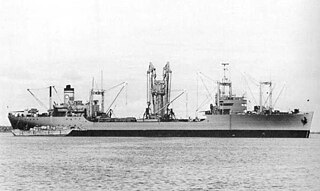
USNS Private Leonard C. Brostrom (T-AK–255) was a cargo ship for the United States Navy that was converted into a heavy lift cargo ship in the early 1950s. She was built in 1943 for the United States Maritime Commission as SS Marine Eagle, a Type C4-S-B1 tank carrier, by Sun Shipbuilding during World War II. In 1948, she was transferred to the United States Army as USAT Private Leonard C. Brostrom after Leonard C. Brostrom, a recipient of the Medal of Honor. In 1950, the ship was transferred to the Military Sea Transport Service of the U.S. Navy as a United States Naval Ship staffed by a civilian crew. After ending her naval service, she entered the National Defense Reserve Fleet in October 1980 and was sold for scrapping in June 1982.

USNS Marine Adder (T-AP–193) was a troop ship for the United States Navy in the 1950s. She was built in 1945 for the United States Maritime Commission as SS Marine Adder, a Type C4-S-A3 troop ship, by the Kaiser Company during World War II. In 1950, the ship was transferred to the Military Sea Transport Service of the U.S. Navy as a United States Naval Ship staffed by a civilian crew. After ending her naval service in 1957, she entered the National Defense Reserve Fleet, but was sold for commercial use in 1967. She was used in part to carry supplies to support the Vietnam War efforts. During the Summer of 1972 while in Da Nang Port, South Vietnam, a limpet mine was attached to the vessel by a swimmer, blowing a hole in the hull upon detonation. In order to save the ship, the Skipper ran it aground in the Da Nang harbor. The US Navy standby salvage ship USS Grasp with its crew of divers installed a box patch over the hole and pumped the water from the bilges, before moving the ship to a pier. US Army tanks hung from ship booms to heel the ship so that a metal patch could be welded in place to return the ship to duty. SS Transcolorado, she was chartered by the Military Sealift Command as a civilian cargo ship designated T-AK-2005.
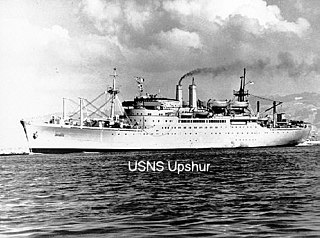
USNS Upshur (T-AP-198), was a Barrett Class transport named in honor of Major General William P. Upshur, USMC.
USNS Marine Carp (T-AP-199) was a Marine Adder-class transport that saw service with the US Navy for the task of transporting troops to and from combat areas. She was of the C4-S-A3 design type.

USS Marine Lynx (T-AP-194) was a Marine Adder-class transport that saw service with the US Navy for the task of transporting troops to and from combat areas. She was of the C4-S-A3 design type.

USS Marine Phoenix (T-AP-195) was a Marine Adder-class transport that saw service with the US Navy for the task of transporting troops to and from combat areas. She was of the C4-S-A3 design type.

USNS Norwalk (T-AK-279) was the first in her class, a Fleet Ballistic Missile Cargo Ship, which was launched as a World War II commercial Victory cargo ship SS Norwalk Victory under the Emergency Shipbuilding program. The Norwalk Victory was acquired by the U.S. Navy in 1963.

USNS Furman (T-AK-280) was a Norwalk class Fleet Ballistic Missile Cargo Ship, which was launched as a World War II commercial Victory cargo ship, the SS Furman Victory under the Emergency Shipbuilding program. The Furman Victory was acquired by the U.S. Navy in 1963.

USNS Victoria (T-AK-281) was a Norwalk-class fleet ballistic missile cargo ship, which was launched as a World War II commercial Victory cargo ship SS Ethiopia Victory under the Emergency Shipbuilding program. The Ethiopia Victory was acquired by the U.S. Navy in 1963.

USNS Marshfield (T-AK-282) was a Fleet Ballistic Missile Cargo Ship, which was launched as a World War II commercial Victory cargo ship SS Marshfield Victory under the Emergency Shipbuilding program. The Marshfield Victory was acquired by the U.S. Navy in 1968.
















